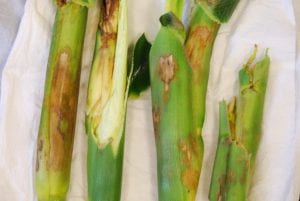Nathan Kleczewski, Extension Specialist – Plant Pathology; nkleczew@udel.edu
A sweet corn sample arrived in the plant clinic this week with bacterial stalk rot. This disease can be an issue where overhead irrigation is used and the water is pumped a surface source such as a lake, ditch, or stream. Disease development is favored by hot temperatures (85-95°F), poor air circulation, and extended periods of wet, humid weather.
The bacterium overwinters in residue above the soil surface and can be inoculated onto corn seedlings through overhead irrigation water. Following inoculation, the bacterium and water are trapped in the whorl and leaf sheaths and enter the plant through natural openings and/or wounds. A soft rot may develop at the base of the whorl and spread into leaves and the stalk. As the disease progresses, a fetid, sweet odor may be detected emanating from the plants. Split stalks typically show internal discoloration and soft rot initiating at the nodes.
Typically affected plants are scattered throughout the field and the disease does not spread from plant to plant. As a result, chemical control with copper-based products is not recommended. If the disease is a reoccurring problem, treating irrigation water in the system with hypochlorite is an option. Fall tillage may help reduce the level of inoculum. During the growing season growers should avoid the excessive use of overhead irrigation to limit disease spread and severity.

